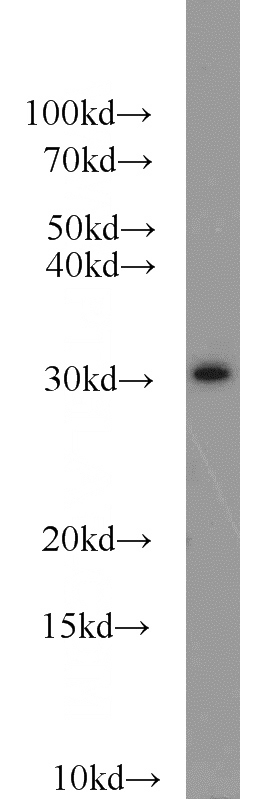-
Product Name
Syntaxin 2 antibody
- Documents
-
Description
Syntaxin 2 Rabbit Polyclonal antibody. Positive WB detected in A431 cells, HeLa cells. Observed molecular weight by Western-blot: 32kd
-
Tested applications
ELISA, WB
-
Species reactivity
Human, Mouse; other species not tested.
-
Alternative names
EPIM antibody; Epimorphin antibody; EPM antibody; STX2 antibody; STX2A antibody; STX2B antibody; STX2C antibody; syntaxin 2 antibody
-
Isotype
Rabbit IgG
-
Preparation
This antibody was obtained by immunization of Peptide (Accession Number: NM_001980). Purification method: Antigen affinity purified.
-
Clonality
Polyclonal
-
Formulation
0.1M NaHCO3, 0.1M glycine, 0.02% sodium azide and 50% glycerol pH 7.3.
-
Storage instructions
Store at -20℃. DO NOT ALIQUOT
-
Applications
Recommended Dilution:
WB: 1:200-1:2000
-
Validations

A431 cells were subjected to SDS PAGE followed by western blot with Catalog No:115796(STX2 antibody) at dilution of 1:800
-
Background
Syntaxin 2 (STX2), also named as EPIM, STX2A, STX2B and STX2C, belongs to the syntaxin family. It is essential for epithelial morphogenesis. STX2 is a member of the SNARE membrane fusion machinery which localized to the midbody during cytokinesis in rat and canine kidney cell lines. Inhibition of STX2 and Vamp8 function by overexpression of nonmembrane-anchored mutants caused failure of cytokinesis leading to the formation of binucleated cells. Time-lapse microscopy showed that only midbody abscission and not further upstream events, such as furrowing, were affected. The antibody is specific to STX2.
Related Products / Services
Please note: All products are "FOR RESEARCH USE ONLY AND ARE NOT INTENDED FOR DIAGNOSTIC OR THERAPEUTIC USE"
